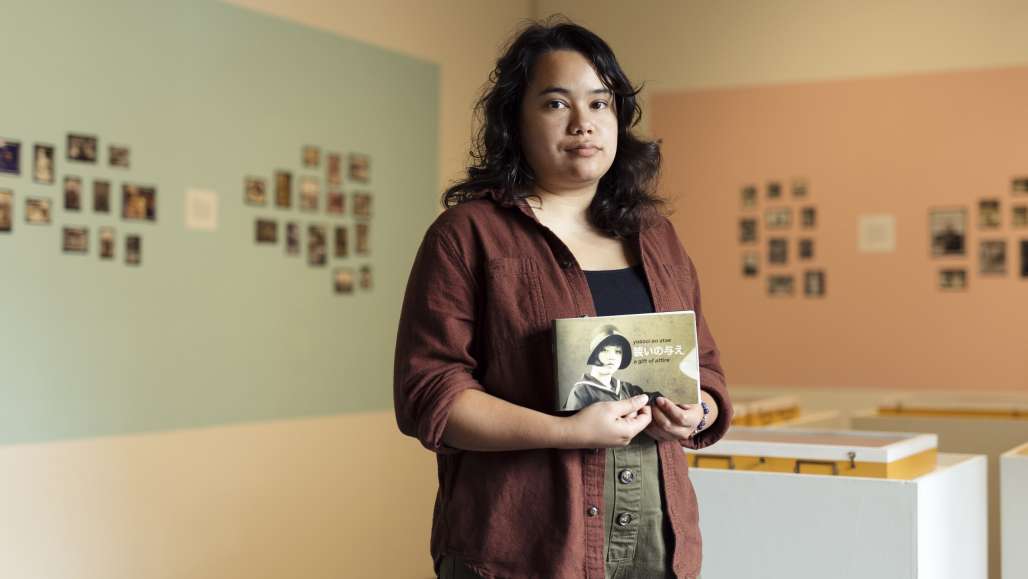For Vitheavy Barton ’24, Exhibit Catalog Sure To Be A Portfolio-Topper

For Vitheavy Barton ’24, going to college was less a leap of faith than a well-timed decision. Vitheavy took two gap years before enrolling at Keene State. It was the right path for her.
It has been a foundation-building and growth-filled experience, the Littleton, New Hampshire native says of her education, and with graduation and real-world realities looming, it has been “wonderful” for her ever-expanding portfolio.
In the Summer of 2023, Vitheavy produced a scholarship-funded 52-page catalog for an exhibit titled Yosooi: Fashion and Vernacular Photography in 20th Century Japan that opened in September at the College’s Thorne-Sagendorph Art Gallery.
Vitheavy used the $4,000 grant to spend part of her summer visiting other museums and galleries, including one at Harvard, to examine photo catalogs; collating and editing photos from the Japan exhibit; and designing the catalog.
Donor- and alumni-funded SURF (Summer Undergraduate Research Fellowship) scholarships offer Keene State student recipients an opportunity to engage in start-to-finish research in their academic discipline. Vitheavy’s grant was endowed by Julian and Julie Landau and was one of four awarded to Keene State students in 2022-23.
The exhibit depicts fashion and everyday life in Japan through family snapshots and ordinary photographs.
Vitheavy is a graphic design major. Her finished product incorporates some of the more than 100 photographs, from disarranged images to fully intact albums. Also included are narratives by the exhibit curators, Lucille Druet and Ayaka Lida, and Vitheavy’s faculty advisers to the project, Jon Gitelson and Rodney Obien.
The exhibit photos are but a small part of a larger private collection of images – more than 3,000 – taken primarily in Japan during the Taisho (1912-1926) and Showa (1926-1989) eras. Vernacular photographs are images not meant to be fine art. That distinction, and the compelling history behind the photos, was not lost on Vitheavy.
“I got a sense of nostalgia, similar to what one feels when looking at an old family album. I wanted to replicate some of those nostalgic feelings, so I included textures and colors pulled straight from the photos and album pages featured in the exhibit. Namely, brown and sepia. Black and grey are also very prominent, as most of the photos from the collection are silver gelatin prints.”
A larger exhibit catalog is in development for the exhibit symposium in early November and will feature many of the same design elements. Gap years are not for everyone, “but for me they were everything,” Vitheavy, an Honors Program enrollee, said. Bottom line, she never looked back.
“Had I gone right out of high school when I was nervous and personally just not ready for college, I don’t think I would have made it.”

A gentle nudge from her grandparents 3,000 miles away in California, and a Keene State academic program that aligned with her academic interests came at “just the right time, and I ended up really, really loving college.”
“I changed so much those two (off) years. I was told that by family and friends. College isn’t for everyone, but it was just where I needed to be. I met my best friend here, I have had small classes that allow me to really connect with my professors, and I’ve had experiences like this catalog project that help to set me up for success.”
Vitheavy has lived on campus all four years, works in the Design Center tutoring other students, and this semester is taking Illustrator 2, Packaging Design, and Sound Design for Video as part of her required Integrative Studies Program credits.
“I’ve always loved art in general. Design is the more logical side of it and more viable for finding work. I’ve had so many opportunities, working with real clients, assisting other students, getting to know all about branding, business, marketing, and client management.”
The catalogs are instrumental to the exhibit and the project was designed to be workplace-like, said Obien, associate professor and head of special collections and archives.
“What is so unique about this project is that it involves a real exhibit, real guest curators, and an opportunity for Vitheavy to be in a real-world situation with real deadlines. We wanted it to be educational. Yes, this is a student, but she is a project designer. We didn’t hold back. I think she felt the burden of the production planning, of completing the catalog. When she wasn’t sure of the next step, that’s when we stepped in to help.”
“Having worked with Vitheavy we know that she is very creative, thoughtful and thorough. And she is quick to ask questions.”
Jonathan Gitelson, chair of the Department of Art & Design, nominated Vitheavy, who was in the Found Japan class that he and Obien taught. He had worked with Vitheavy before in Digital Imaging and was impressed with her work ethic and her work, he said.
“Vitheavy was amazing throughout the process,” Gitelson said. “She participated in every meeting with the curators and worked one-on-one with them. These connections will no doubt have positive professional results in the future. Vitheavy also met with professional catalog designers in New York City to discuss the process and again, build connections.”
Obien said Vitheavy went all out and designed a great catalog. Jon saw something in Vitheavy, Obien said. “He gets all the credit for selecting Vitheavy for this project.”
The sky really is the limit for Vitheavy, Obien said.
“The fruits of her labor, her vision, the experience that Vitheavy has had … it’s the kind of learning that you hope all students can have access to. In this case, we have this talented student, with a modest and humble background, from New Hampshire’s north country, and I can see her being a big-time designer in New York City. She has the chops.”
Vitheavy reflects on her vision of the catalog
“When talking with the curators, we decided to stay away from more detailed illustrative elements in my design so as to not distract from the photos themselves. Instead, the main graphic elements are simply patterned diamonds that feature close-ups of the textiles in the exhibit images. The diamond pattern was inspired by the neckline and patterns found on kimono; a traditional Japanese garment often seen in the photos, in other historic Japanese documentation, and in contemporary Japanese media.”
“As for the font, Indivisible, the clean sans serif type was chosen to support and reference characters from the Japanese writing system. A large and bold version of the title, YOSOOI, featuring more close-ups of textiles, was also developed as a graphic element.”





